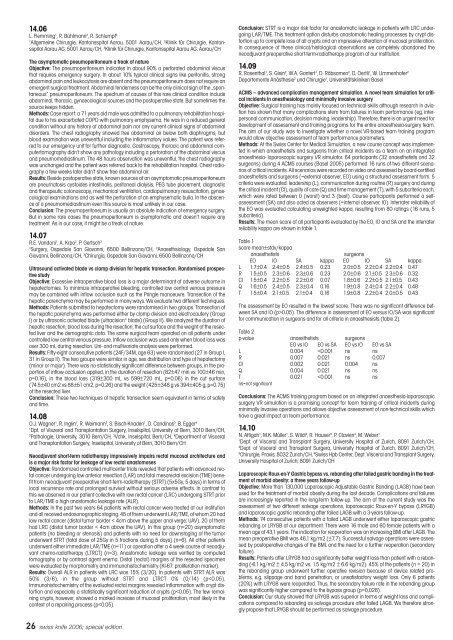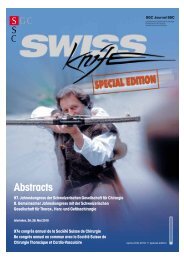Abstracts 4. Gemeinsamer Jahreskongress der ... - SWISS KNIFE
Abstracts 4. Gemeinsamer Jahreskongress der ... - SWISS KNIFE
Abstracts 4. Gemeinsamer Jahreskongress der ... - SWISS KNIFE
You also want an ePaper? Increase the reach of your titles
YUMPU automatically turns print PDFs into web optimized ePapers that Google loves.
swissknife spezial 06 12.06.2006 13:39 Uhr Seite 26<br />
1<strong>4.</strong>06<br />
L. Flemming 1 , R. Bühlmann 2 , R. Schlumpf 3<br />
1 Allgemeine Chirurgie, Kantonsspital Aarau, 5001 Aarau/CH, 2 Klinik für Chirurgie, Kantonsspital<br />
Aarau AG, 5001 Aarau/CH, 3 Klinik für Chirurgie, Kantonsspital Aarau AG, Aarau/CH<br />
The asymptomatic pneumoperitoneum a freak of nature<br />
Objective: The pneumoperitoneum indicates in about 90% a perforated abdominal viscus<br />
that requires emergency surgery. In about 10% typical clinical signs like peritonitis, strong<br />
abdominal pain and leukocytosis are absent and the pneumoperitoneum does not require an<br />
emergent surgical treatment. Abdominal ten<strong>der</strong>ness can be the only clinical sign of the „spontaneous”<br />
pneumoperitoneum. The spectrum of causes of this rare clinical condition include<br />
abdominal, thoracic, gynaecological sources and the postoperative state. But sometimes the<br />
source keeps hidden.<br />
Methods: Case report: a 71 years old male was admitted to a pulmonary rehabilitation hospital<br />
due to his exacerbated COPD with pulmonary emphysema. He was in a reduced general<br />
condition without any history of abdominal pain nor any current clinical signs of abdominal<br />
disor<strong>der</strong>s. The chest radiography showed free abdominal air below both diaphragms, but<br />
blood examination was uneventful including the inflammatory values. The patient was referred<br />
to our emergency unit for further diagnostic. Gastroscopy, thoracic and abdominal computertomography<br />
didn’t show any pathology including a perforation of the abdominal viscus<br />
and pneumomediastinum. The 48 hours observation was uneventful, the chest radiography<br />
was unchanged and the patient was referred back to the rehabilitation hospital. Chest radiography<br />
a few weeks later didn’t show free abdominal air.<br />
Results: Beside postoperative state, known sources of an asymptomatic pneumoperitoneum<br />
are pneumatosis cystoides intestinalis, peritoneal dialysis, PEG tube placement, diagnostic<br />
and therapeutic colonoscopy, mechanical ventilation, cardiopulmonary resuscitation, gynaecological<br />
examinations and as well the perforation of an emphysematic bulla. In the abscence<br />
of a pneumomediastinum even this source is most unlikely in our case.<br />
Conclusion: The pneumoperitoneum is usually an absolute indication of emergency surgery.<br />
But in some rare cases the pneumoperitoneum is asymptomatic and doesn’t require any<br />
treatment. As in our case, it might be a freak of nature.<br />
1<strong>4.</strong>07<br />
R.E. Vandoni 1 , A. Krpo 2 , P. Gertsch 3<br />
1 Surgery, Ospedale San Giovanni, 6500 Bellinzona/CH, 2 Anaesthsiology, Ospedale San<br />
Giovanni, Bellinzona/CH, 3 Chirurgia, Ospedale San Giovanni, 6500 Bellinzona/CH<br />
Ultrasound activated blade vs clamp division for hepatic transection. Randomised prospective<br />
study<br />
Objective: Excessive intraoperative blood loss is a major determinant of adverse outcome in<br />
hepatectomies. To minimize intraoperative bleeding, controlled low central venous pressure<br />
may be combined with inflow occlusion such as the Pringle manoeuvre. Transection of the<br />
hepatic parenchyma may be performed in many ways. We evaluate two different techniques.<br />
Methods: Patients submitted to hepatectomy were randomised in two groups. Transection of<br />
the hepatic parenchyma was performed either by clamp division and electrocautery (Group<br />
I) or by ultrasonic activated blade (ultracision ® blade) (Group II). We analyzed the duration of<br />
hepatic resection, blood loss during the resection, the cut surface and the weight of the resected<br />
liver and the demographic data. The same surgical team operated on all patients un<strong>der</strong><br />
controlled low central venous pressure. Inflow occlusion was used only when blood loss was<br />
over 300 mL during resection. Uni- and multivariate analysis were performed.<br />
Results: Fifty-eight consecutive patients (24F/34M, age 63) were randomised (27 in Group I,<br />
31 in Group II). The two groups were similar in age, sex distribution and type of hepatectomy<br />
(minor or major). There was no statistically significant difference between groups, in the proportion<br />
of inflow occlusion applied, in the duration of resection (82±47 min vs 100±46 min,<br />
p=0.16), in the blood loss (319±300 mL vs 599±720 mL, p=0.06) in the cut surface<br />
(7<strong>4.</strong>5±40 cm2 vs 88±51 cm2, p=0.26) and the weight (425±348 g vs 394±405 g, p=0.75)<br />
of the resected liver.<br />
Conclusion: These two techniques of hepatic transection seem equivalent in terms of safety<br />
and time.<br />
1<strong>4.</strong>08<br />
O.J. Wagner 1 , R. Inglin 1 , R. Weimann 2 , S. Bisch-Knaden 1 , D. Candinas 3 , B. Egger 4<br />
1 Dpt. of Viszeral and Transplantation Surgery, Inselspital, University of Bern, 3010 Bern/CH,<br />
2 Pathologie, University, 3010 Bern/CH, 3 Vchk, Inselspital, Bern/CH, 4 Department of Visceral<br />
and Transplantation Surgery, Inselspital, University of Bern, 3010 Bern/CH<br />
Neoadjuvant short-term radiotherapy impressively impairs rectal mucosal architecture and<br />
is a major risk factor for leakage of low rectal anastomoses<br />
Objective: Randomized controlled multicenter trials revealed that patients with advanced rectal<br />
cancer un<strong>der</strong>going low anterior resection (LAR) and total mesorectal excision (TME) benefit<br />
from neoadjuvant preoperative short-term-radiotherapy (STRT) (5x5Gy, 5 days) in terms of<br />
local recurrence rate and prolonged survival without serious adverse effects. In contrast to<br />
this we observed in our patient collective with low rectal cancer (LRC) un<strong>der</strong>going STRT prior<br />
to LAR/TME a high anastomotic leakage rate (ALR).<br />
Methods: In the past two years 64 patients with rectal cancer were treated at our institution<br />
and all received endosonographic staging. 45 of them un<strong>der</strong>went LAR/TME, of whom 20 had<br />
low rectal cancer (distal tumor bor<strong>der</strong> < 4cm above the upper anal verge; UAV). 20 of them<br />
had LRC (distal tumor bor<strong>der</strong> < 4cm above the UAV). In this group (n=20) asymptomatic<br />
patients (no bleeding or stenosis) and patients with no need for downstaging of the tumor<br />
un<strong>der</strong>went STRT (total dose of 25Gy in 5 fractions during 5 days) (n=6). All other patients<br />
un<strong>der</strong>went either immediate LAR/TME (n=11) or operation after a 4 week course of neoadjuvant<br />
chemo-radiotherapy (LTRCT) (n=3). Anastomotic leakage was verified by computed<br />
tomography or by contrast agent enema. Distal (rectal) margins of the resected specimen<br />
were evaluated by morphometry and immunohistochemistry (KI-67: proliferation marker).<br />
Results: Overall ALR in patients with LRC was 15% (3/20). In patients with STRT ALR was<br />
50% (3/6), in the group without STRT and LTRCT 0% (0/14) (p
















